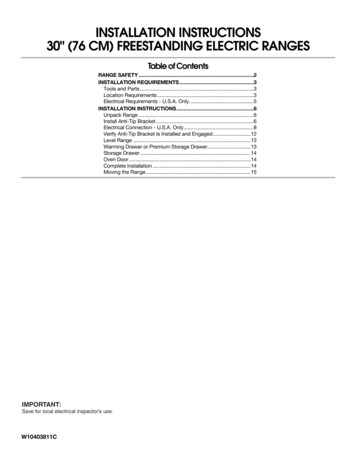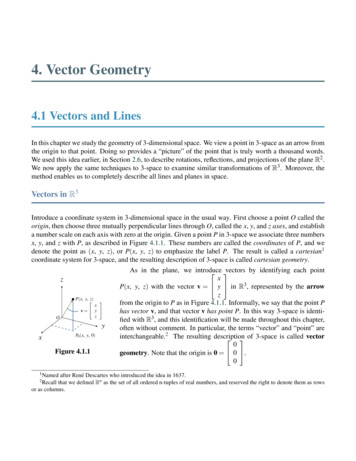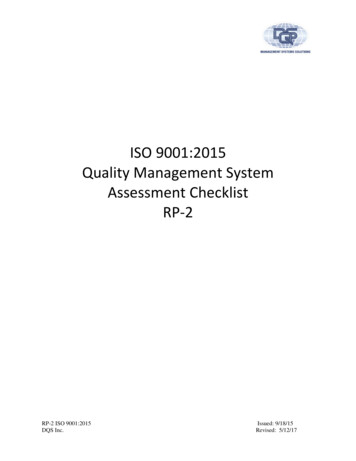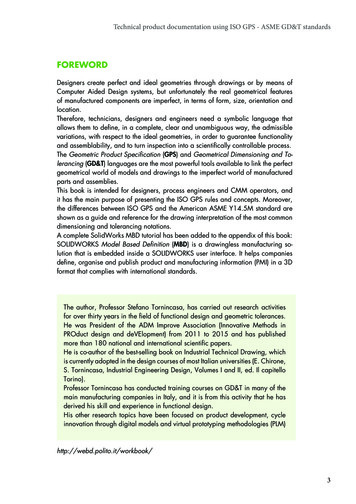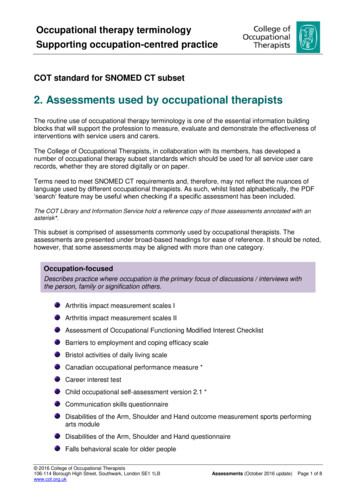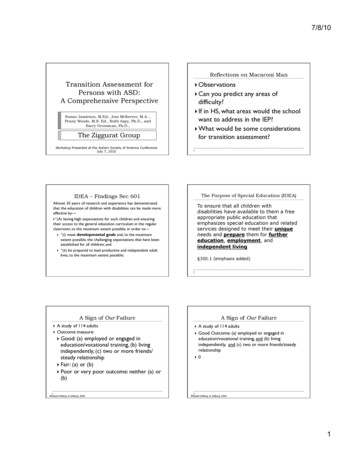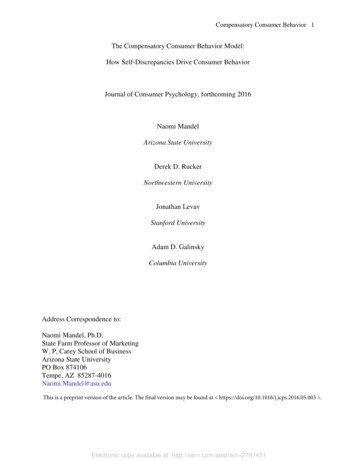
Transcription
1Tip Sheet: Functional Behavior Assessment and Function-Based InterventionsDefinitionFunctional Behavior Assessment (FBA) is a process of gathering information from a variety ofsources to develop a hypothesis regarding why a student is displaying challenging behaviors. Thefunction is assessed in terms of a student’s context/environment. This means determining whathappens before the problem behavior occurs (i.e., antecedents that can lead to or exacerbate theproblem behavior) and what happens after the problem behavior occurs (consequences that canmaintain the behavior). Maintaining consequences are either positive reinforcement (studentmisbehaves to get something such as attention, object, activity, event, sensory stimulation) ornegative reinforcement (student misbehaves to escape/avoid something such as attention, object,activity, event, pain or discomfort). Once a hypothesis has been developed as to why thebehavior occurs, a behavior intervention plan is designed based on the maintaining function todecrease the challenging behavior and increase positive, prosocial behavior (Alberto &Troutman, 2009; Scott et al., 2008)Other TerminologyFunctional Behavior Analysis or Functional Analysis of Behavior (FAB)Rationale (Kerr & Nelson, 2010)Interventions are more successful that are designed to address both the form and function of theproblem behavior than interventions that are designed simply to reduce inappropriate behavior.Instead of focusing on just the definition of a behavior, focus on why a behavior is occurring.Possible function of behavior: To get access to somethingo Social attention (teacher, parent, peer)o Tangible (object, activity, event)o Sensory stimulation (e.g., visual, kinesthetic) To escape or avoid somethingo Social interaction or attention (teacher, peer)o Tangible (object, activity, event)o Demanding tasko Internal pain or discomfortThe benefits include:o Improved behavioral outcomes with a hypothesis-driven intervention;o Increased appropriate, prosocial behaviors with reduced emphasis on punishment;o Increased likelihood of meaningful and lasting change(Alberto & Troutman, 2003; Ingram et al., 2005; Stahr et al., 2006).Implementation: Steps in Functional Behavior Assessment and Function-BasedInterventions (The IRIS Center, 2009). See below for more information on each section.Note: Although the use of FBA with student with challenging behavior is mandated by federallaw, currently there is not a research or federally accepted standardized protocol (Scott et al.,2004).
2Determine the Behavior's FunctionStep 1: Identify and define problem and replacement behaviorsStep 2: Collect dataStep 3: Identify the function of the behavior (gain/get or escape/avoid)Develop and Implement a Function-Based InterventionStep 4: Design a function-based interventionStep 5: Maximize intervention successStep 6: Implement the interventionEvaluate the Effectiveness of the InterventionStep 7: Evaluate the interventionBelow are the steps with more detailed information. See FBA PowerPoint for anexample.Determine the Behavior's FunctionStep 1: Identify and define problem and replacement behaviorso Clear, concise, measurable definitions with examples and nonexamples. See belowfor example: “Non-engagement” is any time Mark is not attending to classroom instructionor completing assigned work assigned.Examples: Making verbal and non-verbal noises without permission; out ofsear without permission; talking or gesturing to other students which isunrelated to the assignmentNon-examples: Looking at teachers during instruction; raising hand to make astatement or request assistance; or working on an assignment during class. “Academic Engagement” is the amount of time Mark spends activelyengaged & working on relevant assignments or activities in academic settings.Examples: Looking at the teacher while she was instructing; working on theassigned tasks; requesting assistance in an acceptable manner; and followingdirections.Non-examples: Not attending to the assigned task; displaying disruptivebehaviors; and breaking classroom rulesStep 2: Collect data (remember to use a variety of both direct and indirect data sources)o Record review - Look for: Academic performanceCould target behaviors be related to an academic skill deficit? History of disciplinary actions or previous interventions What has or has not worked? What has or has not worked? Medical or health factors Other risk factorso Teacher, parent, student interviews – Look for:
3 WHO is present when the student exhibits target behavior?WHAT happens right before the target behavior (antecedent) and whathappens right after the target behavior (consequence)? WHEN does a behavior occur (time of day; Specific activity)? WHERE does a behavior occur? Also, remember to identify when/where/with whom a target does not occur! Example of interview form: The Functional Assessment Interview (O’Neill etal., 1997)o Rating scales Designed to provide information related to function of the target behaviorfunction. Respondents answer questions about the frequency of behaviors.Numerical scores rank order the possible functions A few options Problem Behavior Questionnaire (PBQ; Lewis et al., 1994). Motivational Assessment Scale (MAS; Durand & Crimmins, 1988) The Functional Assessment Analysis Screening Tool (FAST: Iwata &DeLeon, 1996) The Questions about Behavioral Function (QABF; Paclawskyj et al.,2000)o Direct Observation Scatter Plot (Touchette et al., 1985) Use a grid to determine estimated frequency and patterns of targetbehavior across setting and time A-B-C Detailed recording of the antecedents that occur before the targetbehavior and the consequences that occur after the target behavior Baseline Data Collect data on the target and replacement behaviors using frequency,interval, duration, or latencyStep 3: Identify the function of the behavior (gain/get or escape/avoid)o Why is the student behaving this way?o All behaviors occur to GET (access) or GET OUT OF (avoid) something: Attention (peers or teacher) Activities Tangibles Sensoryo When determining the function of the behavior, examine the consequence thatresulted from the behavioro Summarize all data sources using the Function Matrix (See below; Umbreit et al.,2007)o Develop a hypothesis Example: During independent work time and when the teacher is workingwith other students, Steve gets out of his seat and calls out to gain teacherattention.
4Develop and Implement a Function-Based InterventionStep 4: Design a function-based interventiono Determine if and how the replacement behavior needs to be taught (“can’t do” or“won’t do)o Determine antecedent adjustments to prevent problem behavior from occurring and toprompt replacement behavior Examples: change room arrangement; increase teacher prompts; offer choiceso Determine consequence modifications Reinforce replacement behavior Do not reinforce problem behavior (e.g., ignore, use extinction)Step 5: Maximize intervention successo Determine social validityo Evaluate intervention fidelity (AKA implementation fidelity; treatment integrity; Seebelow for example)o Plan for generalization and maintenanceStep 6: Implement the interventionEvaluate the Effectiveness of the InterventionStep 7: Evaluate the interventiono Compare baseline and intervention datao Monitor intervention fidelity datao Implement plans for generalization and maintenanceFunctional Assessment Matrix ExampleAttentionTangibles or Activities,Functions of BehaviorAccess/ObtainEscape/Avoid*Teacher interview: When Steve isout of his seat, teacher goes to hisdesk.*Student interview: Steve says histeacher ignores him when heneeds help.*Rating scale: High rating forteacher attention.*ABC observation: Function ofbehavior appears to be teacherattention.*Teacher interview: Off taskhappens mostly duringindependent seatwork.*Parent interview: Steve tellsparent that the work is too easy,and he gets bored.Sensory ConditionsAdapted from Umbreit, J., Ferro, J., Liaupsin, C. J., & Lane, K. L. (2007). Functional behavioral assessment andfunction-based intervention: An effective, practical approach. Upper Saddle River, NJ: Pearson Press. Figure 5.3,page 84.
5Treatment Integrity Checklist ExampleIntervention ComponentsAntecedentConditionsDid the teacher explain the assignmentsand provide examples?ReinforcementDid Julie choose a peer assistant to helpif she had questions?Did Julie rate her accuracy andcompletion and then check it with apeer?Did Julie receive peer attention aftercompleting each assignment?Mon.Tues.Wed.Did Julie’s peer provide praise?Did the teacher provide praise after allthree assignments were completed?ExtinctionDid the teacher use a brief verbal directfor Julie to finish her work, if needed?Was Julie only allowed to access thecubbies after her work was completed?Teacher initialsEvidence Decreased problem behaviors and increased appropriate behaviors:o Decreases in off-task (Umbreit & Blair, 1997)o Decreases in talking out (Smith & Sugai, 2000)o Increases in levels of task engagement (Umbreit et al., 2004)o Increases in work completion (Brooks et al., 2003)Used with different student populations:o Severe disabilities (Dunlap et al., 1991)o Down Syndrome (Brooks et al., 2003)o Autism (Mancil & Boman, 2010)o Attention deficit disorders (Ervin et al., 1998; Stahr et al., 2006)o Emotional and behavioral disorders (Smith & Sugai, 2000)o At-risk students (Hagan-Burke et al., 2007)o Young children (McLaren & Nelson, 2009)o ELL (Preciado et al., 2009) Used in a variety of educational settings:o Preschool (Wood et al., 2011)o Head start (McLaren & Nelson, 2009)Thurs.Fri.
6ooooGeneral education classrooms (Lane et al., 2006b)Self-contained classrooms (Lane et al., 2006a)Alternative settings (Turton et al., 2010)Family/school collaboration (Blair et al., 2011)ReferencesAlberto, P. A., & Troutman, A. C. (2009). Applied behavior analysis for teachers (8thed.). Upper Saddle River, NJ: Pearson Education, Inc.Blair, K-S. C., Lee, I-S., Cho, S-J., & Dunlap, G. (2011). Positive behavior support throughfamily–school collaboration for young children with autism. Topics in EarlyChildhood Special Education, 31(1), 22-36.Brooks, A., Todd, A. W., Tofflemoyer, S., & Horner, R. H. (2003). Use of functional assessmentand a self-management system to increase academic engagement and work completion.Journal of Positive Behavior Interventions, 5, 144–152.Dunlap, G., Kern-Dunlap, L., Clarke, S., & Robbins, F. R. (1991). Functionalassessment, curriculum revision, and severe behavior problems. Journal of AppliedBehavior Analysis, 24, 387-397.Durand, V., & Crimmins, D. (1988). Identifying the variable maintaining self- injuriousbehaviors. Journal of Autism and Developmental Disorders, 18, 99- 117.Ervin, R. A., DuPaul, G. J., Kern, L., & Friman, P. C. (1998). Classroom-based functional andadjunctive assessments: Proactive approaches to intervention selection for adolescentswith attention deficit hyperactivity disorder. Journal of Applied BehaviorAnalysis, 31(1), 65–78.Hagan-Burke, S., Burke, M. D., & Sugai, G. (2007). Using structural analysis and academic-based intervention for a student at risk of EBD. Behavioral Disorders, 32(3),175–191.Ingram, K., Lewis-Palmer, T., & Sugai, G. (2005). Function-based intervention planning:Comparing the effectiveness of FBA function-based and non-function-based interventionplans. Journal of Positive Behavior Interventions, 7, 224-236.Iwata B.L., &, DeLeon I. G. (1996). The Functional Analysis Screening Tool (FAST).Unpublished Manuscript. University of Florida: Gainesville, FL.Kerr, M. M., & Nelson, C. M. (2010). Strategies for addressing behavior problems in theclassroom (6th ed.). Boston, MA: Pearson.Lane, K. L., Thompson, A., Reske, C., Gable, L., & Barton-Arwood, S. (2006a). Reducing skinpicking via competing activities. Journal of Applied Behavior Analysis, 39, 459-462.
7Lane, K. L., Weisenbach, J. L., Little, M. A., Phillips, A., & Wehby, J. (2006b). Illustrationsof function-based interventions implemented by general education teachers: Buildingcapacity at the school site. Education and Treatment of Children, 29(4), 549–571.Lewis, T. J., Scott, T. M., & Sugai, G. M. (1994). The problem behavior questionnaire: Ateacher-based instrument to develop functional hypotheses of problem behavior ingeneral education classrooms. Diagnostique, 19, 103-115.Mancil, G, R., & Boman, M. (2010). Functional communication training in the classroom, Aguide for success. Preventing School Failure, 54(4), 238-246.McLaren, E. M., & Nelson, C. M. (2009). Using functional behavior assessment to developbehavior Interventions for students in Head Start. Journal of Positive BehavioralIntervention, 11(1), 3-21.O’Neill, R. E., Horner, R. H., Albin, R. A., Storey, J., & Sprague, J. (1997) Functional analysis:A practical guide (2nd ed.). Pacific Grove, CA: Brooks Cole.Paclawskyj, T. R., Matson, J. L., Rush, K. S., Smalls, Y., & Vollmer, T. R. (2000). Questionsabout behavior function (QABF): A behavioral checklist for functional assessment ofaberrant behavior. Research in Developmental Disabilities, 21, 223–229.Preciado, J. A., Horner, R. H., & Baker, S. K. (2009). Using a function-based approachto decrease problem behaviors and increase academic engagement for Latino Englishlanguage learners. The Journal of Special Education, 42(4), 227–240.Scott, T. M, Anderson, C. M., & Spaulding, S. A., (2008). Strategies for developing andcarrying out functional assessment and behavior intervention planning. Preventing SchoolFailure, 52(3), 39-49.Scott, T. M., et al., (2004).Using functional behavior assessment in general education settings:Making a case for effectiveness and efficiency. Behavioral Disorders, 29, 300–323.Smith, B. W., & Sugai, G. (2000). A self-management functional assessment-based behaviorsupport plan for a middle school, student with EBD. Journal of Positive BehaviorInterventions, 2, 208-217.Stahr, B., Cushing, D., Lane, K., & Fox, J., (2006). Efficacy of a function-based interventionin decreasing off-Task behavior exhibited by a student with ADHD. Journal of PositiveBehavior Interventions, 8(4), 201-211.The IRIS Center for Training Enhancements. (2009). Functional Behavioral Assessment:Identifying the Reasons for Problem Behavior and Developing a Behavior Plan.Retrieved on July 1, 2011 from tm.
8Touchette, P. E., MacDonald, R. F., & Langer, S. N. (1985). A scatter plot for identifyingstimulus control of problem behavior. Journal of Applied Behavior Analysis, 18, 343- 351.Turton, A. M., Umbreit, J., & Mathur, S. R. (2010). Systematic function-based intervention foradolescents with emotional and behavioral disorders in an alternative setting: Broadeningthe context. Behavioral Disorders, 36(2), 117-128.Umbreit, J., & Blair, K. B. (1997). Using structural analysis to facilitate the treatment ofnoncompliance and aggression in a young child at-risk for behavioral disorders.Behavioral Disorders, 22, 75-86.Umbreit, J., Ferro, J., Liaupsin, C. J., & Lane, K. L. (2007). Functional behavioral assessmentand function-based intervention: An effective, practical approach. Upper Saddle River,NJ: Pearson Press.Umbreit, J., Lane, K. L., & Dejud, C. (2004). Improving classroom behavior by modifying taskdifficulty: Effects of increasing the difficulty of too easy tasks. Journal of PositiveBehavior Support, 6, 13-20.Wood, B. K., Ferro, J. B., Umbreit, J., & Liaupsin, C. J. (2011). Addressing the challengingbehavior of young children through systematic function-based intervention. Topics inEarly Childhood Special Education, 30 (4), 221-232
behavior occurs, a behavior intervention plan is designed based on the maintaining function to decrease the challenging behavior and increase positive, prosocial behavior (Alberto & Troutman, 2009; Scott et al., 2008) Other Terminology Functional Behavior Analysis or Functional Analysis of Be

